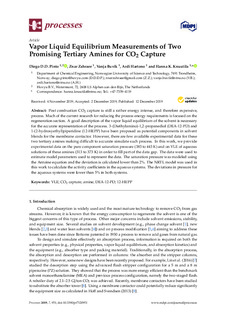| dc.contributor.author | Pinto, Diego Di Domenico | |
| dc.contributor.author | Zahraee, Znar | |
| dc.contributor.author | Buvik, Vanja | |
| dc.contributor.author | Hartono, Ardi | |
| dc.contributor.author | Knuutila, Hanna K | |
| dc.date.accessioned | 2020-01-21T14:13:22Z | |
| dc.date.available | 2020-01-21T14:13:22Z | |
| dc.date.created | 2019-12-19T20:53:44Z | |
| dc.date.issued | 2019 | |
| dc.identifier.issn | 2227-9717 | |
| dc.identifier.uri | http://hdl.handle.net/11250/2637291 | |
| dc.description.abstract | Post combustion CO2 capture is still a rather energy intense, and therefore expensive, process. Much of the current research for reducing the process energy requirements is focused on the regeneration section. A good description of the vapor liquid equilibrium of the solvent is necessary for the accurate representation of the process. 3-(Diethylamino)-1,2-propanediol (DEA-12-PD) and 1-(2-hydroxyethyl)piperidine (12-HEPP) have been proposed as potential components in solvent blends for the membrane contactor. However, there are few available experimental data for these two tertiary amines making difficult to accurate simulate such process. In this work, we provide experimental data on the pure component saturation pressure (383 to 443 K) and on VLE of aqueous solutions of these amines (313 to 373 K) in order to fill part of the data gap. The data were used to estimate model parameters used to represent the data. The saturation pressure was modeled using the Antoine equation and the deviation is calculated lower than 2%. The NRTL model was used in this work to calculate the activity coefficients in the aqueous systems. The deviations in pressure for the aqueous systems were lower than 5% in both systems. | nb_NO |
| dc.language.iso | eng | nb_NO |
| dc.publisher | MDPI | nb_NO |
| dc.relation.uri | https://www.mdpi.com/2227-9717/7/12/951/htm | |
| dc.rights | Navngivelse 4.0 Internasjonal | * |
| dc.rights.uri | http://creativecommons.org/licenses/by/4.0/deed.no | * |
| dc.title | Vapor Liquid Equilibrium Measurements of Two Promising Tertiary Amines for CO2 Capture | nb_NO |
| dc.type | Journal article | nb_NO |
| dc.type | Peer reviewed | nb_NO |
| dc.description.version | publishedVersion | nb_NO |
| dc.source.volume | 7 | nb_NO |
| dc.source.journal | Processes | nb_NO |
| dc.source.issue | 12 | nb_NO |
| dc.identifier.doi | https://doi.org/10.3390/pr7120951 | |
| dc.identifier.cristin | 1763170 | |
| dc.relation.project | Norges forskningsråd: 239789 | nb_NO |
| dc.description.localcode | © 2019 by the authors. Licensee MDPI, Basel, Switzerland. This article is an open access article distributed under the terms and conditions of the Creative Commons Attribution (CC BY) license (http://creativecommons.org/licenses/by/4.0/). | nb_NO |
| cristin.unitcode | 194,66,30,0 | |
| cristin.unitname | Institutt for kjemisk prosessteknologi | |
| cristin.ispublished | true | |
| cristin.fulltext | postprint | |
| cristin.qualitycode | 1 | |

